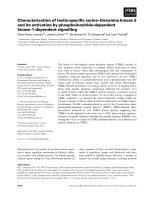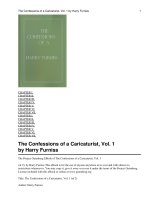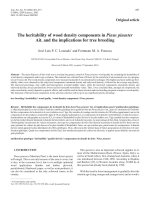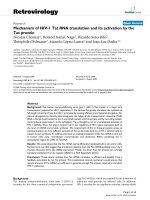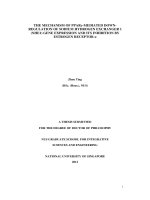THE MECHANISM OF PPARN3 MEDIATED DOWN REGULATION OF SODIUM HYDROGEN EXCHANGER 1 (NHE1) GENE EPXRESSION AND ITS INHIBITION BY ESTROGEN RECEPTOR n1 5
Bạn đang xem bản rút gọn của tài liệu. Xem và tải ngay bản đầy đủ của tài liệu tại đây (7.82 MB, 32 trang )
137
dependent reduction in NHE1 protein expression in ERα-silenced MCF-7 (Figure
21A).
To further confirm that the active ERα present in regular serum blocked the
down-regulation of NHE1 by PPARγ ligand at transcriptional level, cells were
transfected with scrambled control siRNA or ERα siRNA and treated with 15d-
PGJ
2
in regular serum condition for 40h. Following that, cells were harvested for
RNA and subjected to mRNA analysis using real-time PCR. The mRNA data
corroborated with the data on NHE1 protein expression. In regular serum, 5μM of
15d-PGJ
2
failed to induce any changes to the NHE1 mRNA level. However, the
same concentration of 15d-PGJ
2
induced about 50% reduction in NHE1 mRNA
expression when ERα was removed by siRNA (Figure 21C).
To further rule out the possibility that the observed down-regulation of NHE1 by
PPARγ ligand in ERα-silenced MCF-7 cells was due to unspecific gene silencing
by ERα siRNA, ERα was pharmocolically degraded by high concentration of
fulvestrat for 4h before the addition of 15d-PGJ
2
. Fulvestrant is a 7α-
alkylsulphinyl analogue of 17β-estradiol. It functions as an estrogen receptor
antagonist devoid of agonist activities. It was reported that fulvestrant has higher
affinity for estrogen receptors and thus competitively inhibits binding of estrogen
to ERs. It was also shown to degrade estrogen receptors (McClelland et al., 1996).
MCF-7 cells were kept in RPMI supplemented with 10% regular serum for 48h
before 1μM of fulvestrant was introduced. After 4h, the cells were harvested for
analysis of ERα protein expression by Western blot. Figure 23A shows ERα in
MCF-7 were degraded by end of 4h after fulvestrant addition. After ensuring the
138
complete degradation of ERα by fulvestrant, we exposed the cells to 15d-PGJ
2
for
48h. As shown in figure 23B, 15d-PGJ
2
could not inhibit the NHE1 protein
expression in regular serum, but the edogenous PPARγ ligand succeeded in
repressing NHE1 when ERα was removed by fulvestrant (Figure 21B). Again
real-time PCR was performed to assess the NHE1 mRNA level of the same
experimental setting. Nontheless, it should be noted that cells were harvested for
RNA 40h after 15d-PGJ
2
introduction. The mRNA data were highly similar to
that obtained from the ERα silencing experiment, degradation of ERα by
fulvestrant significantly enhanced the inhibitory effect of 15d-PGJ
2
on NHE1
mRNA expression (Figure 21D).
Taken together, the above results demonstrate that the active ERα present in
regular serum interferes with and blocks PPARγ-mediated down-regulation of
NHE1 expression in ER positive MCF-7 cells.
139
140
Figure 21: Reduced ERα level enhances PPARγ-mediated down-regulation of
NHE1 in regular serum conditon.
(A) MCF-7 (1.5 X10
5
cells/6-well dishes) cells were transfected with ERα
specific siRNA or negative siRNA as described in Materials and Methods. After
48h of transfection, ERα expression was determined by Western blot with β-actin
as loading control. The transfected cells were exposed to 15d-PGJ
2
for 48h in
media containing regular serum, and the protein expression of NHE1 was
analyzed by Western blot. NHE1 band intensity was normalized to β-actin. (B)
MCF-7 (2 X10
5
cells/6-well dishes) cells were treated with 15d-PGJ
2
for 48h with
or without 4h pre-incubation of 1µM Fulvestrant, and the protein expression of
NHE1 was analyzed by Western blot. After 4h of Fulvestrant treatment, ERα
141
expression was determined by Western blot. NHE1 band intensity was normalized
to β-actin. (C) MCF-7 (1.5 X10
5
cells/6-well dishes) cells were transfected with
ERα specific siRNA or negative siRNA as described in Materials and Methods.
The transfected cells were exposed to 15d-PGJ
2
for 40h in medium containing
regular serum, and the fold change of NHE1 mRNA expression was determined
by Taqman real-time PCR, normalized to the endogenous control: human 18s.
Relative NHE1 mRNA expression is expressed as percentage of control. Results
denote means +/-SD computed from two experiments done in duplicate. (D)
MCF-7 (1.5 X10
5
cells/6-well dishes) cells were treated with 15d-PGJ
2
for 40h
with or without 4h pre-incubation of 1µM Fulvestrant, and the fold change of
NHE1 mRNA expression was determined by Taqman real-time PCR, normalized
to the endogenous control: human 18s. Relative NHE1 mRNA expression is
expressed as percentage of control. Results denote means +/-SD computed from
two experiments done in duplicate. *, p<0.05, **, p< 0.01, treated versus
untreated control.
3B2.4 Re-expression of ERα in ER negative MDA-MB-231 cells blocks
PPARγ-mediated down-regulationof NHE1.
From the experiemnts shown in section 2.2, we have demonstrated that in ER
positive MCF-7 cells, high estrogen content in regular serum was able to block
the PPARγ-mediated down-regulation of NHE1. At the same time, removing ERα
in these cells restored their response to PPARγ ligand on NHE1. Hence, we asked
whether ER-expressing MDA-MB-231 cells would behave similarly as ER
positive MCF-7 cells in regular serum condition.
The endogenous level of NHE1 and ERα were first assessed in normal MDA-
MB-231 cells and MDA-MB-231 cells stably transfected with ERα (MDA-MB-
231 ER positive cells) using Western blot. The successful re-expression of ERα in
MDA-MB-231 ER positive cells was shown in figure 24A. It is noteworthy that
142
when the cells were kept in RPMI supplemented with regular serum condition, the
basal level of NHE1 mRNA was significantly higher in ER positive MDA-MB-
231 cells compared to that in ER negative MDA-MB-231 cells (Figure 22A).
MDA-MB-231 cells expressing ERα showed 40% more basal NHE1 mRNA level
compared to ER negative MDA-MB-231 cells (Figure 22A). To reaffirm the role
of active ERα receptor, ERα activity was blocked by the ER antagonist
fulvestrant. Breifly, MDA-MB-231 cells stably transfected with ERα were
incubatd with 10nM of fulvestrant for 2h, before 3µM of 15d-PGJ
2
was
introduced. The cells were harvested after 18h and 24h for mRNA and protein
expression respectively. Western blot analysis of the NHE1 protein content shows
ER antagonist itself could significantly bring down NHE1 protein level in regular
serum condition (Figure 22B). This result suggests that the both ERα and PPARγ
were active in regular serum condition, probably due to the high concentration of
estrogen and prostaglandins present. Upon inhibition of ERα by its antagonist, the
activated PPARγ resulted in spontaneous reduction in NHE1 protein level. It is
also noted that addition of 3µM of 15d-PGJ
2
after 2h pre-incubation with 10nM
fulvestrant further enhanced the magnitude of NHE1 down-regulation,
demonstrating that inhibiting ERα could potentiate PPARγ ligand’s effect on
NHE1 expression (Figure 22B). In figure 22C, NHE1 mRNA analysis by real-
time PCR also revealved similar trend of regulation by ERα antagonist and
PPARγ ligand. 10nM of fulvestrant resulted in 30% reduction in NHE1 mRNA in
ER positive MDA-MB-231 cells. It is interesting that in the absence of
fulvestrant, 1µM of 15d-PGJ
2
brought down NHE1 mRNA to 50% of the control.
143
However, after intitial suppression of NHE1 mRNA by fulvestrant, the same
concentration of 15d-PGJ
2
was only able to reduce NHE1 mRNA to 60% of the
control (Figure 22C). This observation suggests that when both PPARγ and ERα
were activated in regular serum, ERα exerted a more dominant effect on PPARγ-
regulated NHE1 expression. The avaiblabiltiy of PPARγ ligand played a less
important role as further addition of PPARγ agonist resulted in a smaller
reduction in NHE1 expression than that with fulvestrant alone.
Together, these data confirm that re-expression of ERα in MDA-MB-231 and its
activation by estrogen present in serum blocks PPARγ-mediated down-regulation
of NHE1 expression.
144
Figure 22: Re-expression of ERα blocks PPARγ-mediated down-regulation of
NHE1in MDA-MB-231 cells kept in regular serum condition.
(A) Endogenous NHE1 mRNA expressions in MDA-MB-231 and MDA-MB-231
ERα+ were determined by Taqman real-time PCR, normalized to the endogenous
control: human 18s. Relative NHE1 mRNA expression is expressed as percentage
of control. Results denote means +/-SD computed from two experiments done in
duplicate. (B) MDA-MB-231 ERα+ (1.5 X10
5
cells/6-well dishes) cells were
treated with 15d-PGJ
2
for 48h with or without 2h pre-incubation of 10nM
Fulvestrant in medium containing 10% regular serum, and the protein expressions
of NHE1 was analyzed by Western blot. NHE1 band intensity was normalized to
β-actin. (C) MDA-MB-231 ERα+ (1.5 X10
5
cells/6-well dishes) cells were treated
with 15d-PGJ
2
for 40h with or without 2h pre-incubation of 10nM Fulvestrant in
media containing 10% regular serum, and the fold change of NHE1 mRNA
expression was determined by Taqman real-time PCR, normalized to the
endogenous control: human 18s. Relative NHE1 mRNA expression is expressed
145
as percentage of control. Results denote means +/-SD computed from two
experiments done in duplicate. *, p< 0.05, treated versus untreated control.
3B.3 TRANSCRIPTIONALLY ACTIVE ERα BLOCKS THE EFFECT
OF PPARγ ON NHE1 EXPRESSION
The results so far from silencing ERα in MCF-7 cells and reexpression ERα in
MDA-MB-231 cells have confirmed the role of ERα in PPARγ-mediated down-
regulation in breast cancer cells. Other than its classical mechanism of
transcriptional action, ERα was reported to elicit non-genomic signaling pathways
by activating MAPK (Mitogen-Activated Protein Kinase) and PKA and PKC
(Protein kinases) (Simoncini et al., 2003). Thus, we wanted to confirm whether
the inhibitory effect of ERα on PPARγ-mediated reduction of NHE1 expression
involves the transcriptional activity of estrogen receptor.
3B3.1 ERα antagonist enhances the PPARγ-mediated NHE1 repression.
Two ERα antagonists fulvestrant and raloxifene were utilized to inhibit the
transcriptional activity of ERα and to examine their subsequent effects on PPARγ-
regulated NHE1 expression. Fulvestrant was shown to bind to ERα, rendering it
incapable of dimerization and transcriptionally inactive by disabling both AF1
and AF2 domains of ERα (Fawell et al., 1990). Raloxifene acts as an estrogen
antagonist in both breast and uterus (Mitlak and Cohen, 1999) by blocking the
accessibility of AF2 domain in ERα receptor (Thiebaud and Secrest, 2001).
To ascertain that both fulvestrant and raloxifene acted as ERα antagonist in our
system, the protein expression of two ERα target genes, progesterone receptor and
146
c-Myc were determined in MCF-7 cells exposed to 10nM fulvestrant and 100nM
raloxifene. As shown in figure 23A, both drugs induced a reduction in expressions
of c-Myc and progesterone receptor after 48h in regular serum condition. The
suppression of the two ERα target genes by fulvestrant and raloxifene
demonstrates that the two antagonists successful inhibited the transcriptional
activity of ERα. Moreover, the transcriptional activity of ERα was assessed using
ERE luciferase reporter assay. Luciferase reporter assay was then performed on
MCF-7 cells exposed to 10nM fulvestrant and 100nM raloxifene in RMPI
supplemented with regular FBS. The ERE reporter activity was measured after 6h.
When ERα receptors were activated by estrogen present in regular serum, both
drugs induced a significant down-regulation of transcriptional activity at ERE
(Figure 23B). This result corroborated with that in figure 24A, confirming that
both fulvestrant and raloxifene were capable of inhibiting the transcriptional
activity of ERα.
Next we investigated how inhibition of ERα’s transcriptional activity by ERα
antagonists would affect its ability to regulate PPARγ-mediated decrement of
NHE1 expression in regular serum condition. ER positive MCF-7 cells were pre-
incubated with 10nM fulvestrant for 6h, before PPARγ ligand 15d-PGJ
2
was
introduced. The cells were harvested for Western blot analysis after 48h. The
extent of NHE1 protein down-regualtion by PPARγ ligand was highly enhanced
when ERα was inhibited by fulvestrant (Figure 23C). The same experimental set
up was repeated with 100nM raloxifene, and it was found that raloxifene similarly
augmented PPARγ-mediated down-regulation in MCF-7 cells. The effect of ERα
147
antagonists on PPARγ-regulated NHE1 expression was also analyzed at
transcriptional level using real-time PCR. In the absence of ERα antagonist, 40h
incubation with 5μM of 15d-PGJ
2
failed to bring down the NHE1 mRNA
expression. However, the same concentration of 15d-PGJ
2
resulted in 20% and 30%
reduction in NHE1 mRNA level when cells were pre-incubated with 10nM
fulvestrant and 100nM raloxifene respectively (Figure 23D).
In this section, we demonstrated that ERα antagonists can inhibit ERα
transcriptional activity and facilitate down-regulation of NHE1 expression by
PPARγ ligand.
148
Figure 23: ERα antagonists enhance PPARγ-mediated down-regulation of
NHE1 in regular serum condition.
(A) MCF-7 (2 X10
5
cells/6-well dishes) cells were treated with 10nM Fulvestrant
or 100nM Raloxifene in media containing 10% regular serum for 48h, and the
protein expressions of c-Myc and progesterone receptor were analyzed by
Western blot, using β-actin as the loading control. (B) MCF-7 (7.5 X 10
4
cells/12-
well dishes) cells were co-transfected with 3µg of reporter plasmid 3X ERE-luc
and 0.3µg of renilla as described in Materials and Methods. 48h after transfection,
the activity of ERα was then determined using luciferase assay and the result was
calculated as luciferase RLU/renilla/µg total. Data represents the average +/- SD
of two experiments done in duplicate. (C) MCF-7 (2 X10
5
cells/6-well dishes)
cells were treated with 15d-PGJ
2
with or without 6h pre-incubation of 100nM
Raloxifene in media containing 10% regular serum for 48h, and the protein
expressions of NHE1 was analyzed by Western blot. NHE1 band intensity was
149
normalized to β-actin. (D) MCF-7 (2 X10
5
cells/6-well dishes) cells were treated
with 15d-PGJ
2
with or without 6h pre-incubation of 10nM Fulvestrant or 100nM
Raloxifene in medium containing 10% regular serum for 40h, and the fold change
of NHE1 mRNA expression was determined by Taqman real-time PCR,
normalized to the endogenous control: human 18s. Relative NHE1 mRNA
expression is expressed as percentage of control. Results denote means +/-SD
computed from two experiments done in duplicate. . *, p<0.05, **, p<0.01, treaed
versus untreated control.
3B3.2 ERα defective in DNA binding enhances the effect of PPARγ ligand on
NHE1 down-regulation.
Having demonstrated that transcriptionally inactivating ERα in regular serum can
facilitate the down-regulation of NHE1 expression by 15d-PGJ
2
, we next
investigated whether the DNA binding ability of ERα was involved in preventing
PPARγ-mediated reduction of NHE1 expression. To this end, we overexpressed a
dominant-negative form of ERα in MCF-7 cells. The DNA binding domain of
dominant-negative ERα contains mutations that rendered it defective in binding to
DNA. As a result, this form of ERα competes with wild type ERα for ligand and
reduces the transcriptional activity of wild type ERα. Luciferase reporter assay on
ERE was performed to validate the loss of transcriptional activity in cells
overexpressed with dominant-negative ERα. MCF-7 cells were transfected with
plasmid encoding ERα defective in DNA-binding, 3X ERE-Luc and Renilla
plasmid. 48h after transfection, the cells were subjected to luciferase reporter
assay to check for transcriptional activity of ERα. As expected, the high ERE
luciferase reporter activity in regular serum was significantly abrogated in cells
transfected with dominant-negative ERα (Figure 24A). Meanwhile, the cells were
150
subjected to Western blot analysis for ERα and its target gene c-Myc content. The
successful overexpression of dominant negative ERα was shown in figure 28B.
The PPARγ receptor level was not altered by overexpression of dominant
negative ERα. However, the expression of ERα response gene c-Myc was reduced
in cells transfected with dominant negative ERα, indicating the attenuated
transcriptional activity of ERα in these cells (Figure 24B).
Next we went on to test the effect of dominant-negative ERα on PPARγ-mediated
regulation of NHE1 expression in MCF-7 cells. MCF-7 cells were transfected
with plasmid encoding dominant negative ERα or parent empty vector as
described in Materials and Methods. 48h after transfection, the cells were treated
with 15d-PGJ
2
in RPMI supplemented with regular serum. The protein level of
NHE1 was analyzed by Western blot after 48h of drug treatment. It was observed
that in cells transfected with the empty vector, 15d-PGJ
2
up to 5μM failed to
induce significant reduction in NHE1 protein expression in regular serum
condition (Figure 24C). This result is in agreement with our previous data in
figure 23C, demonstrating that the activated ERα by serum prevented down-
regulation of NHE1 by PPARγ ligand. However, overexpression of dominant
negative ERα was able to restore the sensitivity of NHE1 expression to PPARγ
ligand. In MCF-7 cells transfected with plasmid encoding DNA-binding defective
ERα receptor, 15d-PGJ
2
resulted in dose-dependent reduction in NHE1 protein
expression (Figure 24C). This result further validated the data we obtained from
experiment of silencing ERα in MCF-7 (Figure 24B): removing ERα completely
by ERα specific siRNA transfection or depleting them from DNA by
151
overexpressing dominant negative ERα both resulted in restored sensitivity to
PPARγ-mediated NHE1 down-regulation.
From the results shown above, we concluded further that the DNA binding ability
of ERα is involved in inhibiting PPARγ-mediated NHE1 repression.
152
153
Figure 24: Transfection of DNA-binding defective ERα enhances PPARγ-
mediated down-regulation of NHE1 in regular serum condition.
(A) MCF-7 (7.5 X 10
4
cells/12-well dishes) cells were co-transfected with 4µg of
plasmid encoding DNA-binding defective ERα or empty vector, 3µg of reporter
plasmid 3X ERE-luc and 0.3µg of renilla as described in Materials and Methods.
48h after transfection, the activity of ERα was then determined using luciferase
assay and the result was calculated as luciferase RLU/renilla/µg total.
Overexpression of ERα after 48h of transfection is shown at top panel. Data
represents the average +/- SD of two experiments done in duplicate. (B) MCF-7
(7.5 X 10
4
cells/12-well dishes) cells were transfected with 4µg of plasmid
encoding DNA-binding defective ERα or empty vector as described in Materials
and Methods. 48h after transfection, the transfected cells were exposed to 15d-
PGJ
2
for 48h in media containing 10% regular serum, and the protein expression
of NHE1 was analyzed by Western blot. NHE1 band intensity was normalized to
β-actin. *, p<0.05, treated versus untreated control.
3B.4 THE MECHANISM BY WHICH ERα BLOCKS THE EFFECT OF
PPARγ ON NHE1 EXPRESSION
3B4.1 ERα does not bind to the putative ERE on NHE1 promoter.
Since the DNA binding ability of ERα was found to be essential in its inhibitory
effect on PPARγ-mediated down-regulation of NHE1, it was hyptotheiszed that
ERα and PPARγ compete sterically for DNA binding site in close proximity, and
activation of ERα by estrogen blocks PPARγ from assessing PPRE on NHE1
promoter. To test this, we again examined the 5’-proximal region of NHE1
promoter for potential Estrogen Response Element (ERE).
As indicated earlier in section 3A1.1, the Alu receptor response elemenent
(AluRRE) located at nucleotide -977 to -990 on human NHE1 promoter is highly
similar to the AluRRE on human MPO promoter (Figure 25A). On MPO
154
promoter, ERα was found to bind to the first DR2 in AluRRE and sterically
blocked PPARγ’s binding to the second DR2 (Kumar et al., 2004). Based on
sequence alignment, we identified the first DR2 within NHE1 AluRRE as a
putative ERE (Figure 25A). Given that NHE1 shares 100% sequence identitiy
with the ERα binding site on MPO (Figure 25A), it is pertinent to ask whether
ERα is able to bind to the first DR2 found in NHE1 AluRRE. To this end, in vitro
binding of ERα to classical ERE and putative NHE1 ERE in both regular and CS
serum conditions was assessed using Noshift Transcription Factor assay as
described in the Materials and Methods. It was observed that the binding
efficiency of ERα to classical ERE was significantly reduced upon treatment with
fulvestrant in regular serum condition, confirming the ERα-antagonistic property
of fulvestrant and its ability to inhibit the interaction between ERα and ERE
(Figure 25B). In CS serum condition, E2 up-regulated the amount of ERα present
at ERE (Figure 25B). However, in both serum conditions, ERα displayed
negligible binding to the identified putative NHE1 ERE (Figure 25B), suggesting
its inability to bind to the first DR2 of NHE1 AluRRE. These data demonstrate
that activated ERα does not bind to the putative NHE1 ERE, hence its interefering
effect on PPARγ-mediated down-regulation of NHE1 expression remains to be
elucidated further.
155
Figure 25: Identification of putative ERE on NHE1 promoter.
(A) The AluRRE of NHE1 promoter is aligned with AluRRE of myeloperoxidase
(MPO) (Kumar et al., 2004).The putative ERE and PPRE in 5’ proximal promoter
region of NHE1 is aligned with the consensus ERE. (B) MCF-7 (1.78 X
10
6
/100mm dish) cells were exposed to 1µM E2 for 4h, before harvesting for
nuclear-cytosol fractionation as described in Materials and Methods. MCF-7 (1.5
X 10
6
/100mm dish) cells were exposed to 10nM Fulvestrant in media containing
10% regular serum for 4h, before harvesting for nuclear-cytosol fractionation as
described in Materials and Methods.The NoShift™ Transcription Factor Assay
was utilized for determination of endogenous ERα binding to putative and
classical ERE as described in Materials and Methods. Results denote means +/-
SD computed from two experiments done in duplicate. **, p<0.01, treated versus
untreated control.
3B4.2 ERα suppresses binding of PPARγ to NHE1 promoter.
Previous studies indicated that ERα expression alters the transcriptional activity
of PPARγ (Wang and Kilgore, 2002), and activated ERα blocks binding of
PPARγ to PPRE on PTEN promoter (Bonofiglio et al., 2005). Next, we asked
156
whether ERα equally inhibited binding of PPARγ to NHE1 PPRE. To achieve this,
we assessed the in vitro and in vivo binding of PPARγ to NHE1 promoter, using
Noshift Transcription Factor assay and ChIP assay in MCF-7 cells. The cells were
exposed to 15d-PGJ
2
for 4h with or without E2 preincubation, before they were
analyzed for binding efficiency of PPARγ to PPRE. As illustrated in figure 28A,
treatment with 15d-PGJ
2
alone significantly enhanced the binding of PPARγ to
oligonucleotides corresponding to NHE1 PPRE sequence (Figure 26A). In
contrast, the same concentration of 15d-PGJ
2
failed to increase the binding of
PPARγ to NHE1 PPRE in the presence of E2 (Figure 26A). Hence, we confirmed
that E2 blocks binding of activated PPARγ to NHE1 PPRE in vitro.
Considering the above observations, we investigated whether activated ERα
inhibited the binding of PPARγ to endogenous PPRE in NHE1 promoter. Thus,
we performed a ChIP assay in MCF-7 cells treated with 15d-PGJ
2
in the presence
or absence of E2. Similar to what we observed in Noshift Transcription Factor
assay (Figure 26A), pre-incubation with E2 successfully abrogated any fold
enrichment brought about by 15d-PGJ
2
at both NHE1 PPRE (NHEnew) and
PTEN (PTEN) PPRE (Figure 26B). This result lends futher support to the
hypothesis that activated ERα blocks recruitment of PPARγ to the PTEN and
NHE1 promoter.
We also screened the PPARγ and ERα ChIP data bases generated by Prof Edison
Liu’s lab in Genome Institue of Singapore (GIS). These two databases
respectively encompass the genome-wide biding sites of PPARγ in 3T3-L1
preadipocyte cells and of ERα in MCF-7 breast cancer cells. Based on the PPARγ
157
database in 3T3-L1, we identified several poteintial PPARγ binding sites on
chromosome 1 (Appendix A), and included them in the ChIP assay. It was
observed that PPARγ ligand significantly induced the recruitment of PPARγ
receptor to sites spanned by primer pairs NHE34 and ERB in MCF-7 cells (Figure
26B). Furthermore, pre-incubation with E2 potently abrogated the enhanced
binding of activated PPARγ to these sites, suggesting that the inhibitory effect of
ERα on PPARγ recruitment to NHE1 and PTEN PPRE could also be extended to
these two new sites.
158
Figure 26: Binding of PPARγ to PPRE is blocked in the presence of estrogen.
(A) MCF-7 (1.78 X 10
6
/100mm dish) cells were exposed to 1µM E2 for 4h,
before harvesting for nuclear-cytosol fractionation as described in Materials and
Methods. The NoShift™ Transcription Factor Assay was utilized for
determination of endogenous PPARγ binding to putative PPRE as described in
Materials and Methods. Results denote means +/-SD computed from two
experiments done in duplicate. (B) MCF-7 (5.4 X 10
6
/10cm dish) cells were
treated with 3M 15d-PGJ
2
for 4h before they are harvested for
Chromatinimmunoprecipitation (ChIP) assay as described in Materials and
Methods. Sheared chromatin was immunoprecipitated using a PPAR antibody
(anti-PPAR). Occupancy of PPARγ on various potential PPREs on chromosome
159
1 and PTEN promoter was analyzed by real-time PCR as relative to input. Results
denote means +/-SE computed from three experiments. *, p<0.05, treated versus
untreated control.
3B4.3 ERα inhibits transactivation of PPARγ
Having ascertained through ChIP assay that all the valid PPRE sites tested
displayed consistent inhibition of PPARγ binding by active ERα (Figure 27B), we
proceeded to assess the effect of active ERα on the general transcriptional activity
of PPARγ by PPRE reporter assay. MCF-7 cells were transfected with 3X PPRE-
Luc or pTA-luc (control plasmid) together with Renilla plasmid as a control for
transfection efficiency. Luciferase reporter assay was then performed on
transfected MCF-7 cells which were exposed to 3μM of 15d-PGJ
2
with or without
2h pre-incubation of E2. Consistent with the ChIP result obtained previously,
15d-PGJ
2
alone significanlty up-regulated the PPRE reporter activity compared to
the untreated control (Figure 27A). On the other hand, the presence of E2
abrogated the PPRE-mediated transcriptional reporter activity induced by 15d-
PGJ
2
(Figure 27A). This result is in good agreement with the literature reports
demonstrating E2-mediated inhibition of PPRE luciferase reported assay in ERα-
expressing MDA-MB-231 cells (Wang and Kilgore, 2002).
Having established that E2 inhibits PPARγ-mediated lucifearse reporter activity
and NHE1 down-regulation, the question remains if this inhibitory effect of E2
extends to functional transcription of other bona fide target genes of PPARγ. Such
PPARγ effecctor genes responsible for its anti-cancer effects include RhoB and
PTEN. It was shown that E2 can reverse the up-regulation of PTEN protein and
160
mRNA expression brought by PPARγ ligand, BRL49653 in MCF-7 cells
(Bonofiglio et al., 2005). More recently, transcriptional up-regulation of RhoB by
activated PPARγ was implicated in anti-proliferative effect of PPARγ agonist,
RS5444 in anaplastic thyroid carcinoma (Marlow et al., 2009). To confirm the
literature report on the effect of PPARγ on RhoB expression, we proceeded to
assess the protein as well as mRNA transcript levels of this target gene. In
accordance with published data, 15d-PGJ
2
was found to enhance the protein
expression of RhoB, confirming their roles as transcriptional targets of PPARγ
(Figure 28B). In line with our hypothesis, pre-incubation with E2 abrogated the
up-regulation of RhoB protein expression by PPARγ ligand. Similarly at
transcriptional level, 15d-PGJ
2
alone induced 2.82 fold increases in RhoB mRNA
transcripts from the untreated control (Figure 27C). On the contrary, presence of
E2 inhibited PPARγ-mediated up-regulation of the gene (Figure 27C). Taken
together, these data suggest that both positive and negative gene regulation of
PPARγ target gene can be blocked by activated ERα.
161
Figure 27: Transcriptional activity of PPARγ is blocked in the presence of
estrogen.
(A) MCF-7 (7.5 X 10
4
cells/12-well dishes) cells were co-transfected with 3µg of
reporter plasmid 3XPPRE-luc and 0.3µg of renilla as described in Materials and
Methods. 48h after transfection, cells were treated with increasing doses of 15d-
PGJ
2
with or without 2h pre-incubation of 1µM E2 for 6h. The activity of PPARγ
was then determined using luciferase assay and the result was calculated as
luciferase RLU/renilla/µg total. Data represents the average +/- SD of two
experiments done in duplicate. (B) MCF-7 (3 X10
5
cells/6-well dishes) cells were
exposed to increasing doses of 3μM 15d-PGJ
2
with or without 2h pre-incubation
of 1µM E2 for 24h, and the protein expressions of RhoB was analyzed by
Western blot, using β-actin as the loading control. MCF-7 (3 X10
5
cells/6-well
dishes) cells were exposed to increasing doses of 3μM 15d-PGJ
2
with or without
2h pre-incubation of 1µM E2 for 6h, and the fold changes of (C) RhoB mRNA


